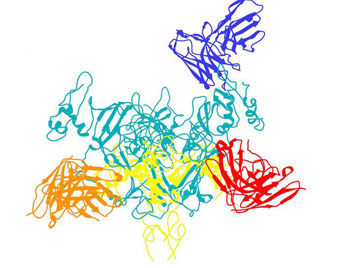High-Resolution Cryo-EM Images Increase Understanding of Anti-Ebola Drug
By LabMedica International staff writers
Posted on 18 Aug 2016
High-resolution cryo-electron microscopy images have revealed more precise information as to how the experimental drug ZMapp binds to the Ebola virus and provide insights into how the drug prevents growth of the pathogen.Posted on 18 Aug 2016
ZMapp, which was developed by Mapp Biopharmaceutical (San Diego, CA, USA), is composed of three monoclonal antibodies (mAbs) that have been chimerized by genetic engineering. The components are chimeric monoclonal antibody c13C6 from a previously existing antibody cocktail called MB-003 and two chimeric mAbs from a different antibody cocktail called ZMab, c2G4 and c4G7.

Image: A molecular model showing the experimental antibody drug ZMapp binding to the Ebola virus, here targeting the virus\'s GP protein (Photo courtesy of Dr. Andrew Ward and Dr. Jesper Pallesen, Scripps Research Institute).
Investigators at The Scripps Research Institute (La Jolla, CA, USA) used high-resolution cryo-electron microscopy (cryo-EM) techniques to study the interaction between ZMapp and two Ebola glycoproteins. The more abundant glycoprotein was the secreted dimeric glycoprotein (sGP). Despite the abundance of sGP during infection, little was known regarding its structure or functional role. A minor product, resulting from transcriptional editing, was the transmembrane-anchored, trimeric viral surface glycoprotein (GP). GP mediated attachment to and entry into host cells, and was the intended target of antibody therapeutics. Because large portions of sequence were shared between GP and sGP, it had been hypothesized that sGP may potentially subvert the immune response or may contribute to pathogenicity.
Researchers have historically relied on NMR and X-ray diffraction techniques to determine the structures of molecular complexes and proteins that play a role in the causes of various disease states. Structural information about a variety of medically important proteins and drugs has been obtained by these methods. Cryo-EM is a complementary analytical technique that provides near-atomic resolution without requirements for crystallization or limits on molecular size and complexity imposed by the other techniques. Cryo-EM allows the observation of specimens that have not been stained or fixed in any way, showing them in their native environment while integrating multiple images to form a three-dimensional model of the sample.
In the August 8, 2016, online edition of the journal Nature Microbiology, the investigators presented the cryo-electron microscopy structures of GP and sGP in complex with GP-specific and GP/sGP cross-reactive antibodies undergoing human clinical trials. The structure of the sGP dimer in complex with both an sGP-specific antibody and a GP/sGP cross-reactive antibody, permitted the investigators to unambiguously assign the oligomeric arrangement of sGP and compare its structure and epitope presentation to those of GP.
"This sGP protein is tremendously important," said Dr. Erica Ollmann Saphire, a professor at the Scripps Research Institute. "This is the roadmap we need to target the right molecules in infection. Eighty to 90% of what Ebola virus makes in infection is this shed molecule. It is like a smoke screen, and we need to know where it is similar to our target GP and where it is different."
Related Links:
Mapp Biopharmaceutical
The Scripps Research Institute













